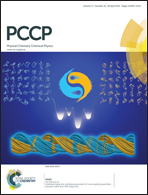Magnetic diffusion anomaly at the Néel temperature of pyrrhotite, Fe1−xS†
Abstract
Cation diffusion is an important rate-limiting process in the growth of pyrrhotite (Fe1−xS) in passivating films on steels exposed to sulfidic environments, and for proposed synthetic applications of Fe1−xS, for example single-phase magnetic switching devices. Above the Néel temperature TN of 315 °C, where Fe1−xS is paramagnetic and structurally disordered, iron self-diffusivity *DFe predictably follows a standard, established Arrhenius law with temperature. However, we report 57Fe tracer diffusion measurements below TN, obtained using secondary ion mass spectrometry (SIMS), that demonstrate a 100-fold reduction in diffusion coefficient as compared to the extrapolated, paramagnetic Arrhenius trend at 150 °C. The results can be described by a magnetic diffusion anomaly, where the vacancy migration energy for the spontaneously-magnetized cation sublattice is increased by approximately 40% over the paramagnetic state. These constitute the first set of consistent diffusivity data obtained in magnetic pyrrhotite, allowing more accurate prediction of pyrrhotite growth rates and determination of magnetic properties for synthetic devices.


 Please wait while we load your content...
Please wait while we load your content...